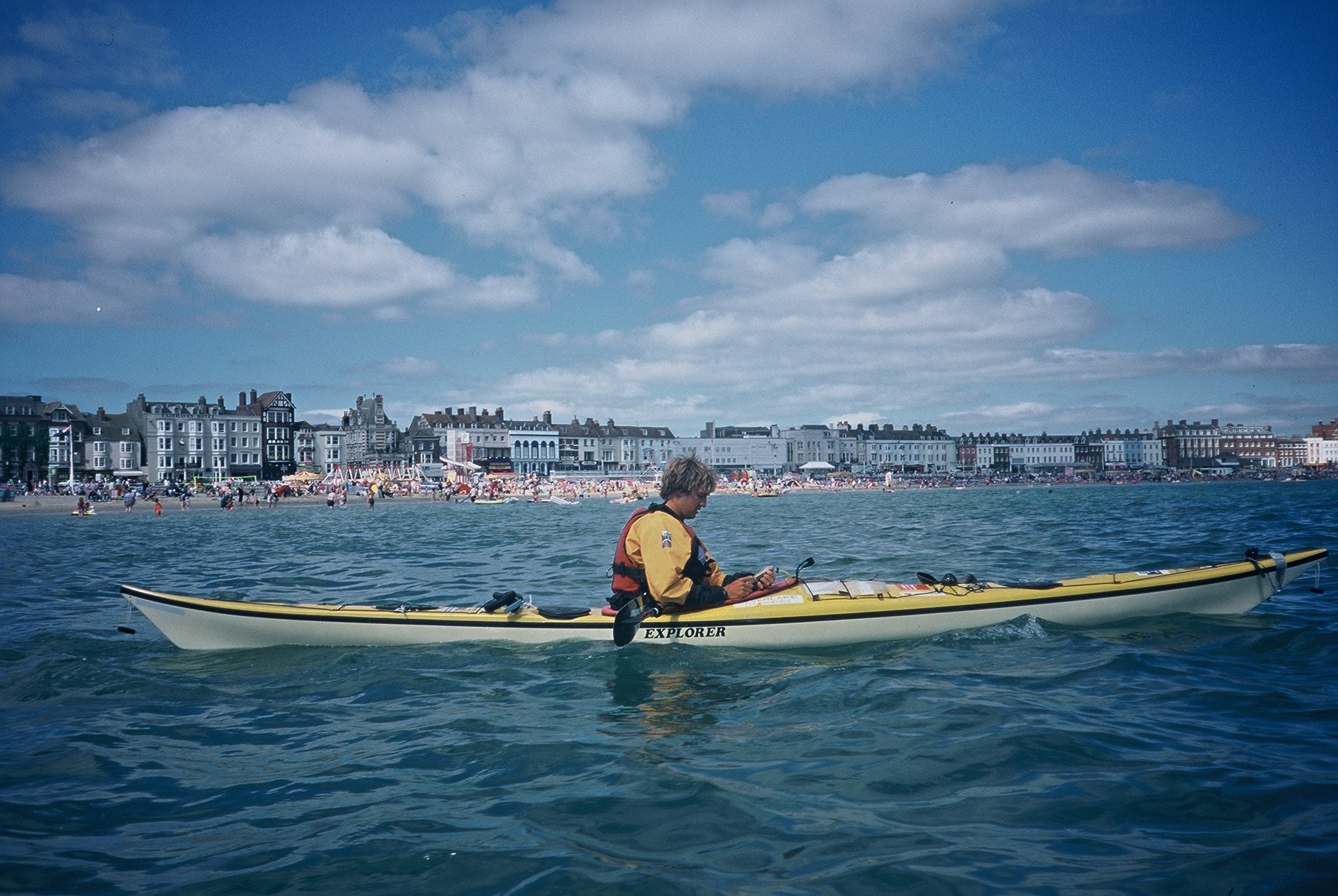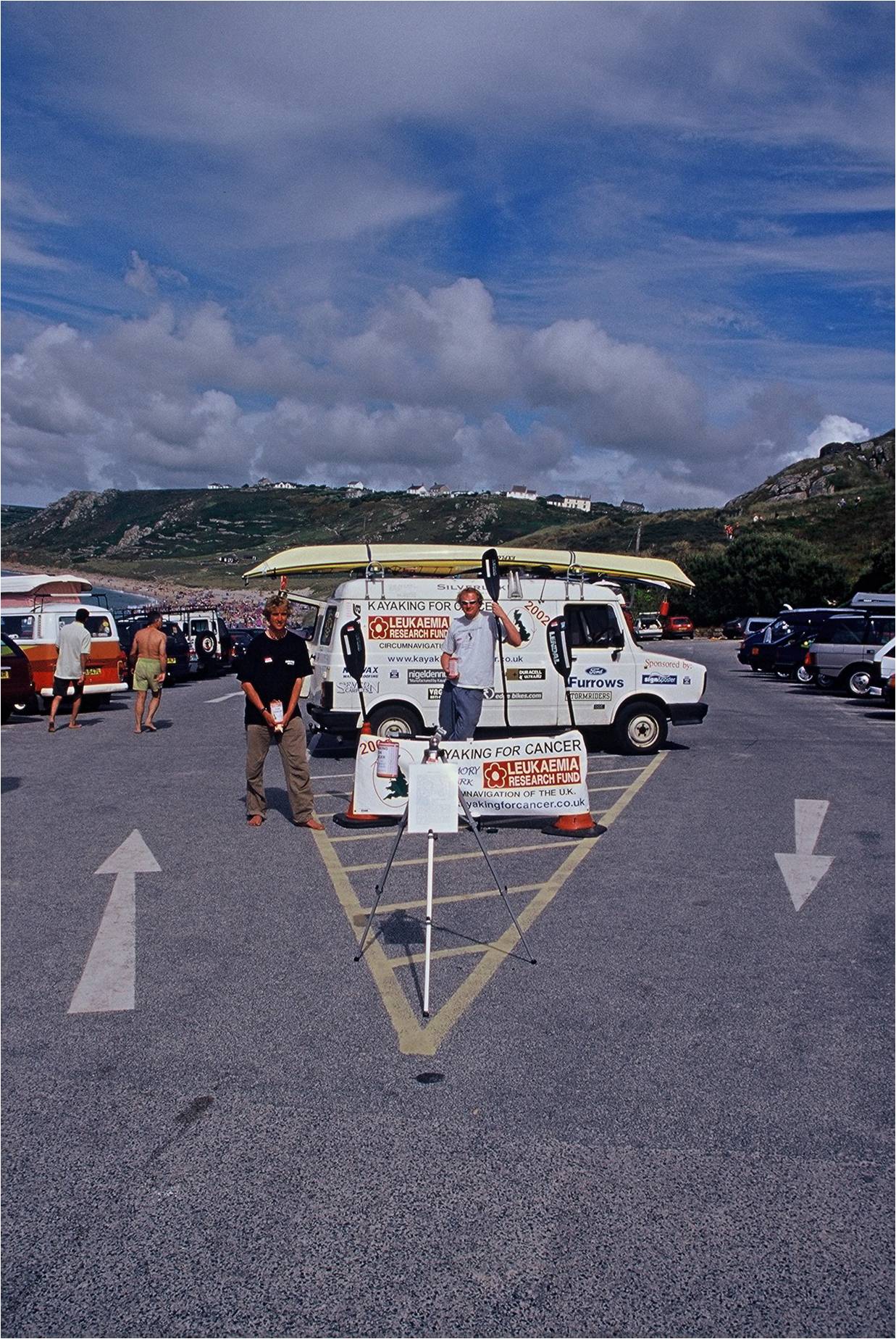Circumnavigation of Great Britain
Dec 06, 2023
In 2002 OSK Coach Simon, became the youngest person to paddle around Great Britain. Here is a draft chapter from a book Simon wrote shortly after he finished but never ended up getting published. We hope it gives you a small insight into this challenging day and the expedition that started Simon off with his passion for sea kayaking.
Chapter 1 - `Morecambe Bay Memories`


I was now 400 meters offshore and the sea began to hint at what the wind would produce the further I went from the shelter of the land. Progress was speedy with the wind pushing me from my back but I was ridged in my boat and needed to loosen up. It wasn’t long before I was surfing the rolling waves and two miles was covered. The wind was scraping the top off the water and moving it in sheets through the air. I knew that the wind was already at force 7 and my heart raced with the thought of 10 more miles to go. To add to the situation that was unfolding in front of me the clouds closed in and my destination slowly faded out of sight. The bearing that I had calculated was all I had to go on for the foreseeable future. The kayak began to turn while it surfed and I struggled to stay on the bearing. I felt very much alone as waves were rolling all around me and I lost sight of all land around me. The buoy that marked the start of the shipping lane was half a mile ahead, which was reassuring because it was marked on the chart in front of me giving a solid reference point. Unsure of my speed until this point I was now able to calculate how long it should be before the safety of the other side. The Lune deep was below me that the large ships used to enter the bay. Swell from the SW was rolling in and I felt so belittled with breakers all around. I looked left and right to check for ships. The ride was nervously exhilarating, but this turned to white fear when a Sea Cat appeared only four miles away, bearing down on my puny 18-foot Nigel Dennis Explorer. Sea Cats are high-speed ferries reaching forty knots and towering seven stories high. They slice effortlessly through the water with twin hulls powered by four Boeing 747 turbine engines. Back paddling furiously into the oncoming breaking waves for five minutes sapped the energy from my arms. I couldn’t turn due to the now gale force winds. Fortunately, the Sea Cat passed a few hundred yards in front, blissfully unaware of my presence. All I had to do now was anxiously wait for the bow wave from the ferry to hit me. It did so with such force that my kayak and I were flung out of the water and given a view of the sea ahead. That view was white and messy, as the waves broke in the shallow waters in the distance. For a split second I thought about the seriousness of the situation I was in. Six miles from land in any direction being tossed about like a cork unable to let go of my paddle for fear of being knocked over. A hint of excitement was greatly shadowed by fear. It dawned on me that the shallow water was causing the swells to tumble over and break. My chart showed the water to be only a couple of meters deep at the present state of tide and this shallow water was marked for the remaining six miles. The waves were steep and I was traveling fast with sheets of water stinging the back of my head. The nose of the kayak, whilst surfing down a wave, hit the wave in front slowing the nose down. As this happened the stern of the kayak came out of the water and I came close to pitch polling. If I had of gone all of the way over, a roll would need to have been performed but the extremely lumpy water would have made it truly difficult. I was glad to have stopped this from happening and I concentrated more on the problem from now onwards. Through all of this, a close eye had to be kept on the compass, as this was the only way I could hit land again. The clouds were still down and I had no physical reference point. Unfortunately I was finding it too much of a challenge to stay on the bearing I had perfectly calculated with painstaking detail the night before. I was being surfed and blown east of my intended destination. Happy that this was up into Morecambe bay rather than out into the Irish Sea, I continued on. Not that I had too much choice! An hour passed on I was feeling as though my body was running on adrenalin only. Land was now clearly back insight and I was looking for the first place to land.
 On the sunny south coast in Weymouth, Dorset
On the sunny south coast in Weymouth, Dorset
The Island of Walney was off to the left of the front of my kayak, which would hopefully provide some shelter to land. There was no obvious place to land as the waves were dumping onto the beach. I paddled around the spit on the inland eastern side of the island and the sea became flat calm. As soon as I landed I felt a wave of relief wash over me and I pulled myself to my feet and walked up the beach to gain a view of the sea I had endured. As I looked back across the twelve miles of white I found it hard to believe I had put myself through it. Now looking back and thinking of my brother Mark and what he went through during his years of Leukaemia, has made me realise how the crossing fitted into the challenge. The promise I made to my brother, days before he died, to raise money for Leukaemia Research was finally being kept. When the plan was put together I wanted something to push me both mentally and physically in a similar way to how Mark was by Leukaemia. This crossing was what the challenge was all about. If everything were to be plain sailing then no one would be interested in sponsoring me and so these sorts of things had to happen. Mark was challenged from the Age of four and throughout his short life and I don’t think that what happened today was even at the bottom of the scale for the mental challenges he met throughout his life. Was this challenge I had set myself more dangerous than he would have wanted me to put the family through? I still had over 2,000 miles left to go and I really didn’t have the experience to take on this challenge. Was I being foolish to think that I could paddle all of the way around Great Britain at 4 miles per hour in an 18 foot sea kayak all on my own on the water? These questions and many more went through my tired head on that wind swept shingle beach. The white caps rolled in as the wind blew foam onto the small beach. What was I to do now? The thought of paddling against the tide and swells to get around the coast passed Barrow-in-Furness was far from appealing. Because of problems getting a replacement GPS my Dad needed to stay in Blackpool for another night to wait for a new GPS to arrive. I didn’t feel like camping on the exposed beach so I decided it would be good to head in behind the Isle of Walney to Barrow. The island is eleven miles long but less than a mile wide. The water on the sheltered side was so different to the sea I had been on earlier and I knew that only a mile away the sea raged with the same fury as it had in the bay earlier. Paddling along with the wind doing all of the work on the sheltered flat-water, swift progress was made towards the town. I realised that the isle of Walney was only connected at low tide and now it was high. It was therefore possible to kayak under the Jubilee Bridge that connected the island to the mainland. People looked curiously down at me from the bridge. I wondered what they must think of me kayaking alone on what was a very bleak day. They would have been somewhat surprised if they knew the whole story that brought me to this moment in time. The chain of events started when my dad introduced me and my brother to kayaking when I was seven. The next link in the chain of events was a promise I made to my brother just before he died to raise money to help cure other people with Leukaemia. Finally, a drunken conversation while at university brainstorming ideas for an event to raise money ended in me declaring that I would kayak around Great Britain. At this time I did not know how far it was, if it had been done before and more importantly I had never sat in a sea kayak before.

Raising money at Lands end, Cornwall on a rare sunny day off the water
Full access to the OSK Library of courses and content
Free 7 day trial
Access to the full OSK Library of courses + Community
Accelerate your skills development
Get unlimited support and feedback from the OSK Coaches
Increase your navigation and planning knowledge
Become a safer paddler
Get inspiration
Learn about kayaks and equipment
Interact with a growing community of paddlers
A whole year of learning for less than a day of on water coaching

